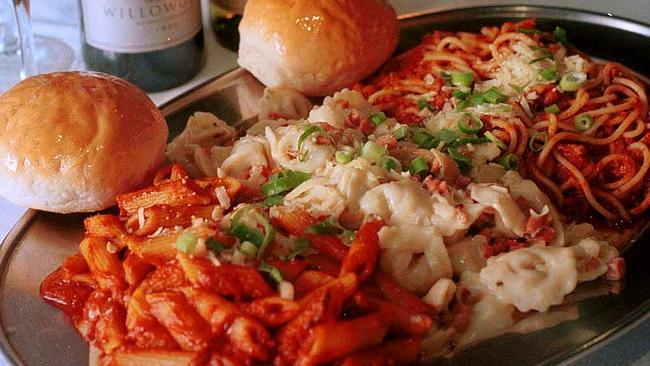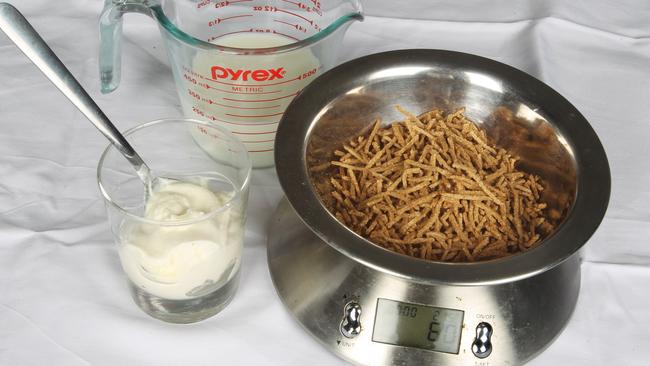Portion sizes vs. recommended serves: How much should you really be eating?
THE studies are in and size - meal size - does matter. Are you biting off more than you should chew?
Health
Don't miss out on the headlines from Health. Followed categories will be added to My News.
OVER the past few decades, portion sizes have steadily crept up and people are unintentionally consuming more kilojoules. The truth is people tend to eat what they are served.
Portions vs. servings
Most Aussies don’t know the difference between a portion and a serve and to be honest it’s confusing.
A recent Australian study, lead by Professor Claire Collins at the University of Newcastle compared what adults and children deem as typical portions of a variety of foods with the standard serving sizes. In this study, participants were independently asked to serve out their typical portion of 10 common foods, including rice, pasta, breakfast cereal, chocolate, ice cream, meat, vegetables, soft drink and milk.
Results showed a large degree of difference between people’s estimation of typical portion size compared to national recommendations.

What’s the difference?
A serving is a set amount of food or drink, such as one slice of bread or one cup of milk.
A portion is the amount of food that you choose to eat for a meal or snack, which is often dictated by the size of the packet you buy or the dish you order. For example, your portion size at breakfast may be half a small tub of yoghurt on your 1 cup muesli. This equates to half a ‘serve’ of yoghurt, but four ‘serves’ of muesli.
Food selection guides such as the Australian Guide to Healthy Eating recommend the number of servings that should be consumed from each food group for a healthy diet. They show how to meet minimum nutrient requirements and balance in terms of fat, carbohydrate and protein.
So how much should I be eating?
The amount of energy (kilojoules) you need each day to maintain your weight depends on your age, gender, height, weight and physical activity levels. But the average adult these are the number and size of recommended servings from the five food groups.

Grain foods: 6 servings (One serve = 1 slice of bread, ½ cup cooked rice or ½ cup cooked pasta)
Vegetables/ legumes: 4-6 servings (One serve = ½ cup cooked veg or legumes, ½ potato)
Fruit: 2 servings (One serve = 1 apple, 1 banana, 1 ½ tablespoons dried fruit)
Dairy: 2 ½ — 4 servings (One serve = 1 cup milk, 2 slices of cheese, ¾ cup yoghurt)
Lean meat or nuts: 2 ½ — 3 servings (One serve = 65g cooked meat, 100g cooked fish, 2 eggs, 80g cooked chicken, 170g tofu)

Easy tricks avoid portion distortion
Be label wary: Do not assume that the serving size information listed is what you will actually eat. Pay close attention to the actual size (weight or volume) listed on the label, as well as the number of suggested servings per package. Even if you eat the entire packet that appears to be marketed for one person, the information on the serving size often states that it contains multiple servings.
Measure up: Bring out those measuring cups and kitchen scales, and spend one day weighing and measuring. This will help you become familiar with recommended serving sizes so that you can then compare these servings to how much you actually eat. Or simply divide your plate into quarters and fill half with salad or veg, a quarter carbs and a quarter protein.
Dish it out: How many times have you sat with a bag or package of food and eaten much more than you planned? To avoid this from happening time and time again, pre-portion your meals or snacks and never eat directly from a box or bag that contains multiple servings. If you’re eating takeaway food, transfer the right portion onto a plate and put the package away.
Think small: If you find yourself carelessly filling your brekkie bowl with double the serving size of cereal, it’s time to downsize your dinnerware. The size of your plate or bowl is one of the biggest factors influencing the amount you eat.
Eat mindfully: Mindful eating heightens awareness of exactly how much you need to eat and portion size, and reduces automatic food habits like overeating while multi-tasking or watching TV. By eating ‘mindfully’, you will enjoy food more and end up needing less to feel satisfied.
Kathleen Alleaume is a nutrition and Exercise Scientist and Author of What’s Eating You? @therightbalance
Originally published as Portion sizes vs. recommended serves: How much should you really be eating?







